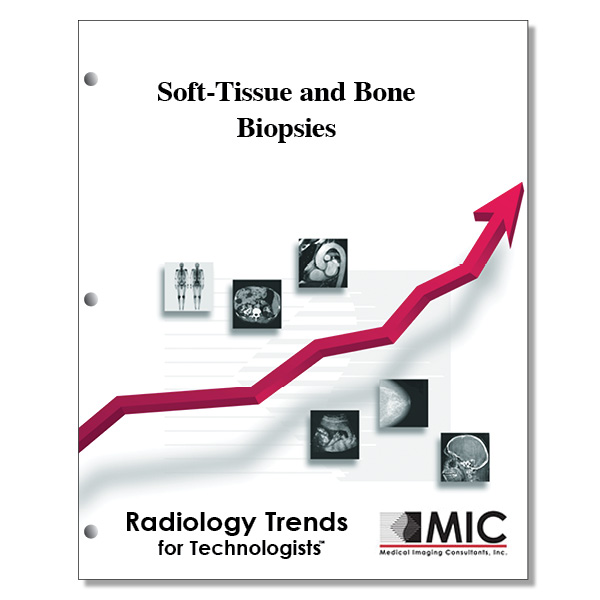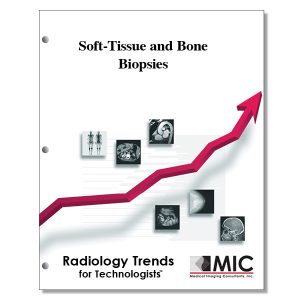

Soft-Tissue and Bone Biopsies
A comprehensive review of pertinent preprocedural, periprocedural, and postprocedural considerations for bone and soft-tissue musculoskeletal biopsies.
Course ID: Q00632 Category: Radiology Trends for Technologists Modalities: CT, MRI, Radiography, Sonography4.0 |
Satisfaction Guarantee |
$39.00
- Targeted CE
- Outline
- Objectives
Targeted CE per ARRT’s Discipline, Category, and Subcategory classification:
[Note: Discipline-specific Targeted CE credits may be less than the total Category A credits approved for this course.]
Computed Tomography: 1.50
Procedures: 1.50
Head, Spine, and Musculoskeletal: 1.50
Magnetic Resonance Imaging: 1.50
Procedures: 1.50
Musculoskeletal: 1.50
Radiography: 1.50
Procedures: 1.50
Extremity Procedures: 1.50
Registered Radiologist Assistant: 3.50
Patient Care: 0.25
Pharmacology: 0.25
Procedures: 3.25
Musculoskeletal and Endocrine Sections: 3.25
Sonography: 2.00
Procedures: 2.00
Superficial Structures and Other Sonographic Procedures: 2.00
Outline
- Introduction
- Preprocedural Considerations
- Problem-Solving Tools and Diagnostic Dilemmas for Evaluation of Biopsy Requests
- Value of Contrast Material and Color Doppler US
- Evaluation of Joint-Based Abnormalities and Tumor Arthrography
- Stress versus Pathologic Fracture
- Tumor versus Infection
- Hematoma versus Hemorrhagic Neoplasm
- Recognizing Diffuse Marrow Infiltration
- Biopsy Planning
- Biopsy Planning with the Orthopedic Oncologist
- Primary Tumor versus Metastases
- Modality Selection
- Factors the Affect Biopsy Yield
- Intralesional Targeting
- Planning the Primary Tumor Biopsy Route
- Upper Extremities
- Humerus
- Forearm
- Lower Extremities
- Hip and Pelvis
- Thigh
- Lower Leg
- Technically Challenging Biopsies
- Patient Factors
- Coagulation Parameters and Anticoagulants
- Local Anesthetics and Moderate Sedation
- Common Local Anesthetics
- Minimal and Moderate Sedation
- Common Moderate Sedation Medications
- Pharmacologic Reversal Agents
- Upper Extremities
- CT- and US-Guided Biopsy Techniques
- CT-Guided Biopsy
- US-Guided Biopsy
- Order Entry and Specimen Handling
- Interpreting Biopsy Results
- Value of Nondiagnostic Biopsy Results
- When to Consider Repeat Biopsy
- Radiologic-Pathologic Correlation
- Posttreatment Imaging and Surveillance
- Tumor Recurrence
- Conclusion
Objectives
Upon completion of this course, students will:
- describe the benefits of percutaneous biopsies
- list post-procedural considerations for soft-tissue and bone biopsies
- describe how intralesional vascularity can be diagnosed
- state the benefit of direct MR and CT arthrography in the diagnosis and determination of soft-tissue ganglia
- recall the patient population most often affected by pathologic fracture
- list where pathologic fractures most commonly occur
- state the preferred imaging modality for further evaluation of stress versus pathologic fractures
- state the most helpful MR imaging sequences to differentiate between pathologic and stress fracture
- state the percent of pathologic fractures that never fully heal
- describe the penumbra sign
- state the sensitivity of the penumbra sign for isolated soft-tissue infections
- compare Ewing sarcoma to osteomyelitis
- state the imaging modality used to differentiate between bland hematoma and hemorrhagic sarcoma
- describe the wall of a bland hematoma
- describe hemorrhagic sarcomas as seen at MR imaging
- explain the pitfalls of not planning appropriately for biopsies
- state the complication rate for open biopsy
- list the factors to consider when selecting a lesion for core needle biopsy
- list the considerations for selecting the best imaging modality for performing biopsies
- choose the modality that is not typically feasible or necessary for guided biopsy
- choose the modality that is ideal for percutaneous sampling of superficial soft-tissue lesions
- name the type of probe useful for superficial biopsies in regions with irregular or sharply rounded contours and narrow acoustic windows
- choose the preferred modality for image-guided biopsies of lesions in the bones, deep soft tissues, or extensive subcutaneous fat superficial to a lesion
- state the diagnostic yield for all core needle biopsies
- list the operator technical factors that affect biopsy yield
- list the benefits of using a coaxial battery-powered bone biopsy system
- choose the lesions most likely to produce a diagnostic sample
- state the patient position for a humeral biopsy
- choose the correct approach for a biopsy of the radial head and neck
- state areas in the forearm that should be avoided during biopsy
- give the patient position for a biopsy of the distal femoral diaphysis and adjacent soft tissue
- give the patient position for a biopsy of the tibia and fibulal
- ist the challenges associated with biopsy of the ribs or sternuml
- ist the factors associated with increased diagnostic yield in image-guided rib biopsiesr
- ecall patient responsibilities during biopsies
- compare the use of local anesthesia to moderate sedation or anesthesia
- list the levels of sedation as defined by the American Society of Anesthesiologists
- list the steps that should be taken in the case of an overly sedated patient
- choose what step is repeated during CT-guided biopsy in order to obtain adequate specimens
- list the factors associated with higher risk of local tumor recurrence
